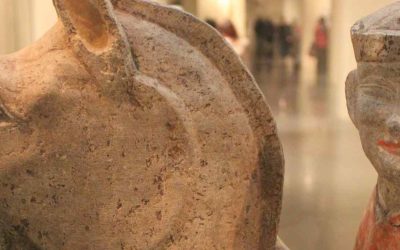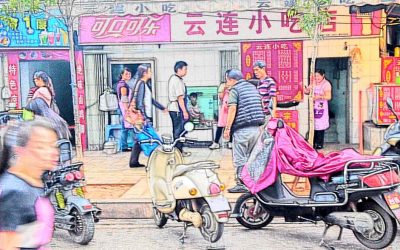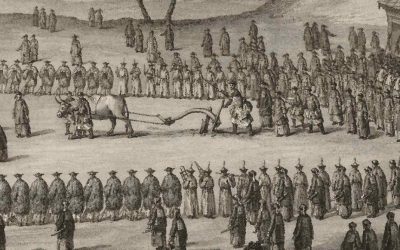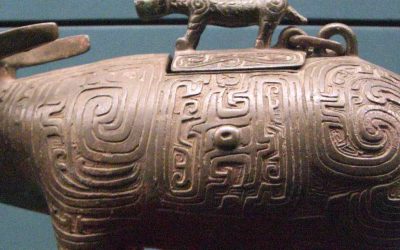Laozi’s Mother is the goddess who created the world
In Taoist thought, great mysteries are not explained with definitive statements, but with paradoxical images, fragmentary myths, and bodily metaphors. One such mystery is the origin of the world—and for Taoism, that origin does not lie in a creation “from the outside,” with a god shaping reality, but in an internal process of transformation, where chaos gives birth to order, and order returns to chaos.
Since the early centuries of our era, the figure of Laozi, the Old Master, began to change. He transformed from a wise philosopher into the incarnation of the Dao itself. He became both the origin and the body of the Dao. But in this cosmology, it is sometimes forgotten that he himself was born of a mother: the so-called Mother Li, the Jade Maiden of the Dark Mystery.
The Mother of Laozi as the creator of the universe
Mother Li is therefore the creator of the universe for the Taoists—a very special kind of creation, as it arises not from an external command but from the continuous transformations that nourish the Dao, from that endless cycle of creation and destruction that, for Taoism, is the very fabric of the world. In fact, much like in other cosmogonies, the birth of Laozi is accompanied by the death of Mother Li.
According to Taoist texts, Laozi was born without a father. He was conceived when his mother absorbed a drop of “heavenly dew.” During the day, she was pregnant; at night, the Old Lord would leave her womb to study the Dao. Thus, he spent more than eighty years in gestation, awaiting the perfect day to be born—a day when birth and death would no longer exist. Finally, he was born through his mother’s armpit, already with white hair and beard, and departed without looking back. Upon seeing him, his mother fell dead from the shock—or, in more benevolent versions, she ascended to the heavens in a chariot of clouds, after revealing to her son the secrets of immortality[1].
The Mother of Laozi is not a mere passive vehicle: she is the very matrix of the cosmos. “The Dao has taken form in her. Through her, it has revealed itself” (Schipper 2011: 150). She is the intermediary between non-being and being, between the undifferentiated void and the world of the “ten thousand things.”
But the myth does not end there. Some texts claim that it was Laozi himself who created his mother—that he first transformed into the Jade Maiden and then reabsorbed himself into her in order to be reborn. The maternal womb and the primordial chaos are the same: the point from which all multiplicity begins.
In Taoism, there is no external creator.
This myth suggests a theology profoundly different from the one we’re used to. In Taoism, there is no external creator. The universe was not made “out of nothing,” but emerged from chaos like a child from its mother. That is why creation is always transformation, constant mutation. Laozi himself declares: “I transform my body, passing through death to live again. I die and am reborn, and each time I have a new body.”
And yet, what dies is not lost—it is transformed. So taught Laozi’s mother in her brief dialogue before disappearing: that true life is spontaneous action, and that death is not an end but a passage to another form of existence. The Dao does not create—it transmutes. It does not impose form—it lets things become. And it does so, always, through the body of the Mother.
The universe is born from when the Dao manifests in a woman.
The importance of this scene cannot be overstated: the universe is born from chaos when the Dao manifests in a woman. In fact, the birth of Laozi is synchronized with the creation of the universe. At the moment of his birth, when the mother’s body opens, the “Heavenly Treasures in Vermilion Script” also appear—revealed scriptures containing the principles of the cosmos. As in other foundational myths (see the biblical Genesis), word and birth are simultaneous. But in this case, it is the female body that opens as a cosmic womb.
Although many modern readings of Taoism focus solely on Laozi as the author of the Daodejing, we must not overlook his mother. Through her, the cycle of constant transformation is revealed. Creation as a continuous process of death and regeneration. The figure of Mother Li is not a mythological detail: she is the very heart of the Taoist vision of the universe. She is the primordial matrix, the vessel of the Dao, the mother goddess who gives shape to all things.
Perhaps, in this vision, there is something profoundly liberating. Instead of an all-powerful god who creates from outside, we find a universe born like a child in the womb of a nameless mother, without beginning or end. A universe that is ourselves. A body that dies and is reborn. A mystery that reveals itself just when we allow it to be.
[1] This post is based in the information provided by Schipper, Kristofer. The Wholeness of Chaos: Laozi on the Beginning. In Schipper et al. China’s creation and origin myths. Brill. 2011.
About me: I have spent 30 years in China, much of the time traveling and studying this country’s culture. My most popular research focuses on Chinese characters (Chinese Characters: An Easy Learning Method Based on Their Etymology and Evolution), Matriarchy in China (there is a book with this title), and minority cultures (The Naxi of Southwest China). In my travels, I have specialized in Yunnan, Tibet, the Silk Road, and other lesser-known places. Feel free to write to me if you’re planning a trip to China. The travel agency I collaborate with offers excellent service at an unbeatable price. You’ll find my email below.
Last posts
The horse in the Chinese horoscope
The horse in the Chinese horoscope The horse is one of the animals of later incorporation into Chinese culture. If, as some scholars say, the system of 12 animals in the Chinese horoscope originated in the peoples who lived in the north, in the steppes and deserts...
The rat in the Chinese horoscope
The rat in the Chinese horoscope The rat for the Chinese is an animal to which are associated some positive and some negative qualities, in fact it is considered capable of carrying out numerous enterprises, not in vain it was the first animal to be assigned a sign of...
An oriental interpretation of dreams
An oriental interpretation of dreams Last week, in a book about the Hani minority in the remote Jinping region, one of the authors devoted part of his article on divination to dream interpretation among the Hani. I translated it, added some comments and published it...
What does it mean to dream of a cow in China? We tell you here
What does it mean to dream of a cow in China? We tell you here In the last few days I have stumbled upon several documents dealing with dreams in China, and some with certain fragments explaining, in particular, the meaning of dreaming about a cow. One of the most...
The ox and the ritual plow in springtime
The ox and the ritual plow in springtime Throughout the imperial era, every year the beginning of agricultural work was celebrated by a solemn ceremony called the Plowing Festival. "The emperor himself would take a yellow plow attached to a yellow ox (yellow was the...
The bull and the political development of Neolithic China
The bull and the political development of Neolithic China Since the history of the penetration of domestic cattle in China goes parallel to that of the political concentration that gave rise to the first cities and later to the first states, that slow penetration of...










